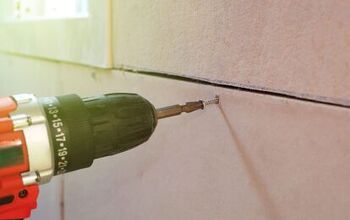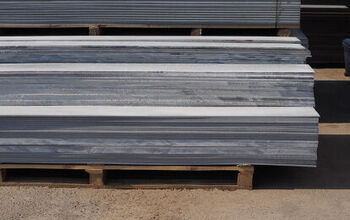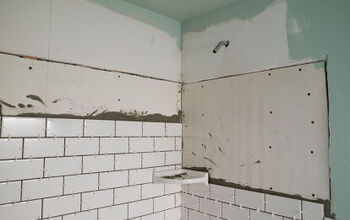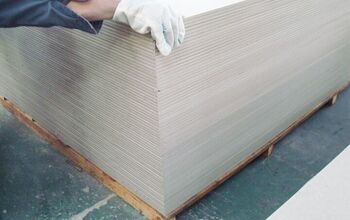Cement Board Screws Vs. Drywall Screws: What Is The Difference?

Both drywall and cement board come in panels, though that is where the similarities between the two end. Cement boards are exceptionally hard, made of a cement slurry and reinforced with fiberglass mesh. It is manufactured to create a strong foundation for installing tile and stone, while also resisting direct moisture.
Drywall panels, on the other hand, are compressed gypsum panels with a paper facing. They serve as an alternative to the traditional lath-and-plaster method of building interior walls. Since these two types of panels are so different, they require different methods of installation. More specifically, they require different fasteners, which brings us to the question at hand –what is the difference between drywall screws and cement board screws?
In short, drywall screws are specifically designed to be used with drywall and cement board screws are specifically designed to be used with cement board. The reason for this is because cement board screws are outfitted with a special coating that makes them resistant to corrosion.
With that said, let’s dive in a little deeper to understand the specific characteristics of each screw type and why certain screws are designed for certain applications.
Do You Need to Hire a Siding Contractor?
Get free, zero-commitment quotes from pro contractors near you.

What Are Cement Board Screws?
Simply put, cement board screws are specifically engineered for cement board installation. They may be provided or offered from the manufacturer of the cement board, or purchased separately from at a home improvement or hardware retailer. What distinguishes these screws from other types is the corrosion-resistant coating that prevents corrosion caused by the high alkali levels present in cement boards.
Depending on the manufacturer, most cement board screws are designed for longevity and ease of installation. As such, they are outfitted with a sharp point and deep-recessed head to make installing cement board quick and easy, reducing the likelihood of cam-outs. These screws are the optimal solution for fastening cement board to wood or steel framing.
Oftentimes, they feature a small groove under the screw head that allows them to dig deep into the cement board, ensuring that the materials are tightly held together. As a result, cement board screws provide a more uniform base for tile, walls, floors, backsplash and counter applications.
What Are Drywall Screws?
Intended to only be used for fastening drywall panels, ranging in length from 1 inch to 3 inches. They feature a “bugle” head that is engineered to slightly countersink in the surface of a drywall panel, without ripping into the protective paper covering on the panel. With these self-tapping screws, no predrilling is necessary. Once they hit the wood studs or joist, they will dig right in.
Standard drywall screws are ideal for installing drywall panels to wood studs. However, if you plan to install drywall over metal framing, you’ll want to opt for screws that specify that operate with metal studs. To install drywall screws, you also need a drywall dimple bit, as it’s not always included in standard bit sets.
The bit looks similar to a Phillips head bit, with the addition of a small protective ring, also called a “shoulder,” located at the tip of the bit. This prevents the screw from being driven into the drywall too deeply. Consider opting for a drywall screws that feature phosphate-coated heads, as these will help the drywall compound to properly adhere during taping.
Cement Board Screws vs. Drywall Screws
Cement board screws are designed for – and should only be used to fasten – cement boards. Likewise, drywall screws are designed for – and should be used exclusively with installing – drywall panels. If you were to use a cement board screw in drywall, or vice versa, this could lead to potential damage in the future as these screws are simply only compatible with specific materials.
When cement boards are used with drywall panels, they will tear up the drywall. Whereas, drywall screws will deteriorate over time and won’t provide proper fastening when used with cement boards. Additionally, cement board screws are outfitted with a special coating that resists corrosion, a feature that is essential to have due to the alkali levels found in the cement of cement boards.
Other Screws You Should Know
The screw aisle and your local home improvement can be difficult to navigate, as different projects require different screws. With more time spent building and repairing things around the home, you’ll become more familiar with the various types of screws out there and what applications they are intended for. Aside from drywall screws and cement board screws, here are some other types of screws that you should be aware of:
1. Wood Screws
Wood screws include course threads that allow them to grip wood tightly until the shank just under the head. The smooth screw shank creates a tighter connection when attaching wood to wood. As the screw is driven to roughly full depth, the smooth section spins freely so that the head doesn’t get forced deeper into the wood.
Meanwhile, the tip of the screw’s threaded design hooks onto the bottom piece of wood, which draws the two wood pieces snugly together. Whereas, the tapered head on wood screws allow them to sit level or slightly below the surface of the wood.
When it comes to choosing wood screws of standard wood construction, choose a length that allows the top of the screw to pierce the bottom board by roughly 2/3 of the thickness of the board. In addition to lengths, widths of wood screws also vary – from #0 to #20 (or, between 1/16 inch and 5/16 inch in diameter). Although #8 is the most common size wood screw, the one you select will depend on your specific project.
2. Masonry Screws
Also known as “anchors,” masonry screws are distinguished by their lack of pointed tip. They do not bore their own holes, instead, you have to predrill a hole before you can insert a masonry screw. These screws may have Philips heads, while others have raised hex-heads that necessitate the use of a matching hex-head bit to install.
Consult the packaging of the masonry screws to determine the specific bit and size that is needed to predrill the holes and then install the anchor itself. You’ll need to use a hammer drill with a masonry bit for predrilling, while a standard drill can be used for driving the masonry screws.
Do You Need to Hire a Siding Contractor?
Get free, zero-commitment quotes from pro contractors near you.

3. Decking Screws
Decking screws are designed to be used for fastening decking, or “deck flooring,” to the joist system of a deck. They are engineered to countersink, such that the heads are flush and just slightly below the wood surface. Like wood screws, decking screws are outfitted with coarse threads and a smooth shank. They are also created to resist corrosion and rust, as they are commonly used for exterior applications.
For pressure-treated wood decking, only use decking screws that are ACQ compatible. Whereas composite decks are intended to be installed with stainless steel decking.
4. MDF Screws
MDF, or Medium Density Fiberboard, is a material that is commonly found in the home in interior trim and in the construction of some shelving, bookcases, and other furniture pieces that are labelled “some assembly-required.” Since it is harder than solid wood, MDF is typically more difficult to penetrate without splitting than conventional wood screws.
You can choose to use regular wood screws with MDF, and just predrill pilot holes. However, self-tapping MDF screws will significantly reduce your work time. They come in the same sizes as regular wood screws and are outfitted with star-drive heads that help eliminate splitting and simplify predrilling.

Jessica considers herself a home improvement and design enthusiast. She grew up surrounded by constant home improvement projects and owes most of what she knows to helping her dad renovate her childhood home. Being a Los Angeles resident, Jessica spends a lot of her time looking for her next DIY project and sharing her love for home design.
More by Jessica Stone


























![Cost To Drill A Well [Pricing Per Foot & Cost By State]](https://cdn-fastly.upgradedhome.com/media/2023/07/31/9074980/cost-to-drill-a-well-pricing-per-foot-cost-by-state.jpg?size=350x220)
